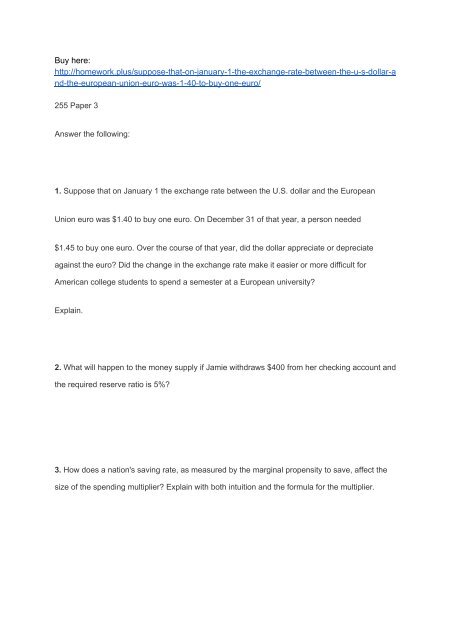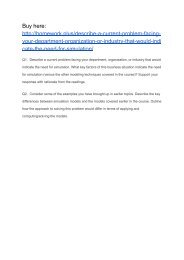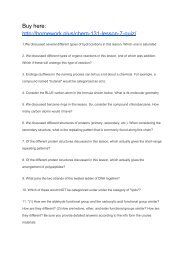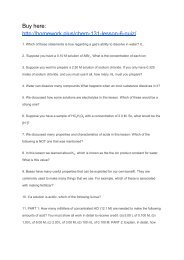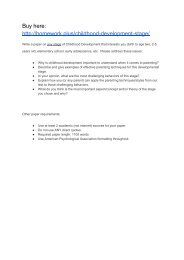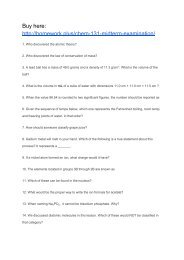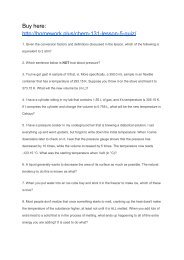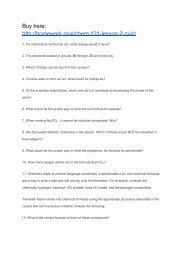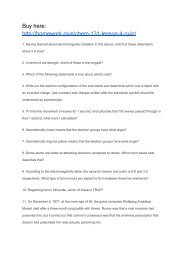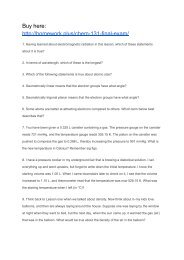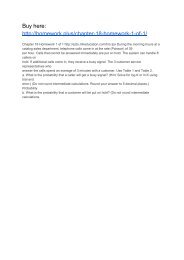Suppose that on January 1 the exchange rate between the U.S. dollar and the European Union euro was $1.40 to buy one euro
Suppose that on January 1 the exchange rate between the U.S. dollar and the European Union euro was $1.40 to buy one euro
Suppose that on January 1 the exchange rate between the U.S. dollar and the European Union euro was $1.40 to buy one euro
Create successful ePaper yourself
Turn your PDF publications into a flip-book with our unique Google optimized e-Paper software.
Buy here:<br />
http://homework.plus/suppose-<str<strong>on</strong>g>that</str<strong>on</strong>g>-<strong>on</strong>-january-1-<strong>the</strong>-<strong>exchange</strong>-<strong>rate</strong>-<strong>between</strong>-<strong>the</strong>-u-s-<strong>dollar</strong>-a<br />
nd-<strong>the</strong>-<strong>euro</strong>pean-uni<strong>on</strong>-<strong>euro</strong>-<strong>was</strong>-1-40-<strong>to</strong>-<strong>buy</strong>-<strong>on</strong>e-<strong>euro</strong>/<br />
255 Paper 3<br />
Answer <strong>the</strong> following:<br />
1. <str<strong>on</strong>g>Suppose</str<strong>on</strong>g> <str<strong>on</strong>g>that</str<strong>on</strong>g> <strong>on</strong> <strong>January</strong> 1 <strong>the</strong> <strong>exchange</strong> <strong>rate</strong> <strong>between</strong> <strong>the</strong> U.S. <strong>dollar</strong> <strong>and</strong> <strong>the</strong> <strong>European</strong><br />
Uni<strong>on</strong> <strong>euro</strong> <strong>was</strong> <strong>$1.40</strong> <strong>to</strong> <strong>buy</strong> <strong>on</strong>e <strong>euro</strong>. On December 31 of <str<strong>on</strong>g>that</str<strong>on</strong>g> year, a pers<strong>on</strong> needed<br />
$1.45 <strong>to</strong> <strong>buy</strong> <strong>on</strong>e <strong>euro</strong>. Over <strong>the</strong> course of <str<strong>on</strong>g>that</str<strong>on</strong>g> year, did <strong>the</strong> <strong>dollar</strong> appreciate or depreciate<br />
against <strong>the</strong> <strong>euro</strong>? Did <strong>the</strong> change in <strong>the</strong> <strong>exchange</strong> <strong>rate</strong> make it easier or more difficult for<br />
American college students <strong>to</strong> spend a semester at a <strong>European</strong> university?<br />
Explain.<br />
2. What will happen <strong>to</strong> <strong>the</strong> m<strong>on</strong>ey supply if Jamie withdraws $400 from her checking account <strong>and</strong><br />
<strong>the</strong> required reserve ratio is 5%?<br />
3. How does a nati<strong>on</strong>'s saving <strong>rate</strong>, as measured by <strong>the</strong> marginal propensity <strong>to</strong> save, affect <strong>the</strong><br />
size of <strong>the</strong> spending multiplier? Explain with both intuiti<strong>on</strong> <strong>and</strong> <strong>the</strong> formula for <strong>the</strong> multiplier.
4. What is meant by <strong>the</strong> term “social insurance”. Give an example of a social insurance program.<br />
5. What is <strong>the</strong> goal of expansi<strong>on</strong>ary m<strong>on</strong>etary policy <strong>and</strong> how does it work in <strong>the</strong> short run?<br />
6. Most ec<strong>on</strong>omists do not support a law <str<strong>on</strong>g>that</str<strong>on</strong>g> requires <strong>the</strong> federal budget <strong>to</strong> be balanced every<br />
year. Explain why.<br />
7. Explain <strong>the</strong> difference <strong>between</strong> fiscal <strong>and</strong> m<strong>on</strong>etary policy.


